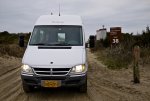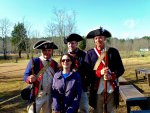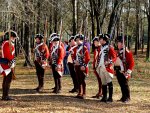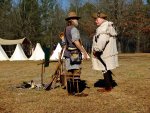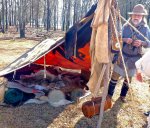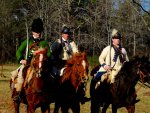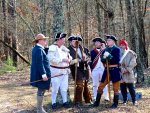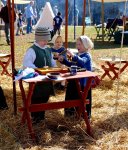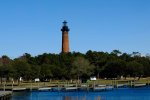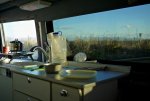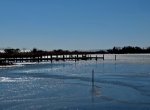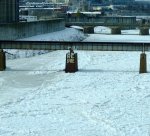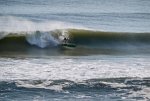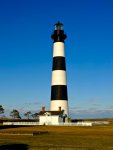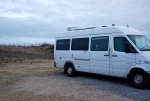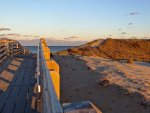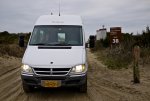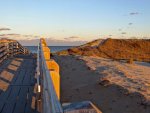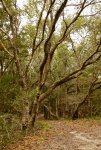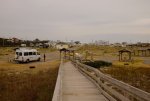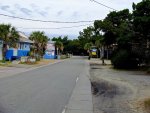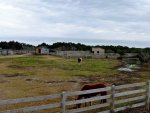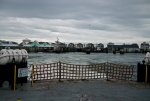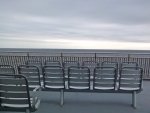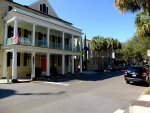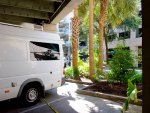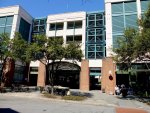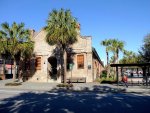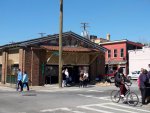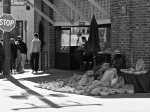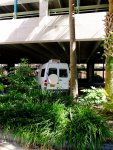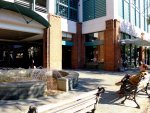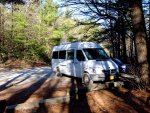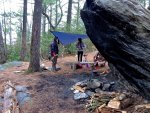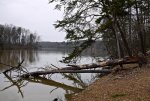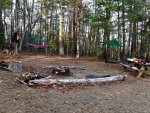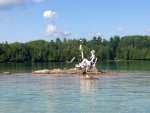Repairs
Repairs
We've put about 21,000 miles on the Cabin on the Road in the past 15 months (as of February, 2016) and it now has just over 36,000 miles. The first run from Austin to Olympia was in December of 2014. The van stayed in Washington State through May, 2015 when we drove it from Seattle to Skagway where it went by ferry to Juneau. From there it has traveled to Yellowknife, Newfoundland the Atlantic Provinces and down the east coast to western North Carolina. Our average highway mileage has been around 24 mpg and overall it is at 22 — these are results from my math, not an on board computer. The best return on fuel is when driving around 55 mph (26 mpg), the worst is a couple of weeks of driving around town including the 2 miles to and from Eve's work each day. However, even city driving results in around 19-20 mpg.
The oil has been changed four times since the purchase. The first in Austin, then in Juneau, Halifax and just recently here in Shelby, N.C. Synthetic oil isn't cheap. Our least expensive service was in Halifax, but that was with the 30% favorable exchange rate and a credit card that doesn't charge for those transactions. The others were about $160 for the 10 liters of oil, filter, fees, and service. The oil being the greatest cost. I guess those synthetic dinosaurs are getting harder to find and turn into oil, as the price hasn't dropped with that of a barrel of oil. And, as an Alaskan I know at what price a barrel of oil is trading.
Alternator
Although there are not many miles on the van, it is getting somewhat long in the tooth at 10 model years old. The alternator and battery had to be replaced in December. The battery warning light came on after starting the van on a very cold morning. Being the optimist, I assumed that it was just an indication that the battery was having some problems with the cold (I can tighten bolts and change tires, lamps and oil, but know little else about automobiles), so I assumed it would go away after driving Eve to work. It didn't. The next morning the van started easily but the light remained. We drove 25 miles and went for a long hike, then back to the van, which started up just fine. Stopped for fuel and the van started again with no problems. Parked that evening and woke the next morning thinking we would drive about 40 miles to Charlotte, NC. Made it about 3 miles when a slew of other lights dotted the instrument panel and the van went into Limp Home Mode. I had read about this, but was amazed just how limiting it was. It ran, but not fast or well. We made it home and I called a couple of friends who know of these things and both suggested it was the alternator. I called a truck repair shop nearby Monday morning, but they didn't work on Sprinters and suggested another place a bit farther out of town.
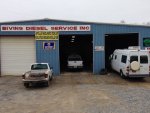
Bivins Diesel Service is old school truck repair, and a most welcoming place. That same Southeast Alaskan mentality that knows the price of oil, also assumes that parts will take a long time to be found and shipped; minimum three days. And that the price of all of this will be exorbitant. Before leaving home for the shop I called Enterprise and asked about a car rental, assuming that the alternator would take a couple of days to arrive. I had to be jump started, which got the van going, though still in Limp Home Mode all the way to the garage. Once there, I was greeted by a couple of mechanics who started testing while I spoke to one of the owners. The mechanic came in and confirmed the need for a new alternator and that the battery was in need of replacement. I told the owner that I could arrange for Enterprise to come by with a car, and could they keep the van for a couple of days on their lot. He looked at me like I was a little crazy and said to hold off on the car rental. He then phoned NAPA and in a few minutes an alternator was on its way. I was dumbfounded. He offered me a Sun Drop and some some Christmas candy and told me to hang around. I also got an invitation to the First Baptist Christmas Eve service, which we ended up accepting as part of our cultural experience of the South. That's a different story, but it does give a hint of the hospitality we have received in western North Carolina.
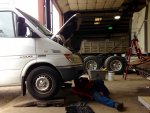
I looked around the garage and saw two dump trucks, a Sprinter, an Isuzu and a very large Freight Liner. There were two more big rigs out front waiting for parts, and another having a mud flap replaced. A F450, owned by the local Salvation Army, came in for its annual DOT inspection. Dan, the mechanic, put our van on small ramps and started taking things apart. The alternator and battery arrived shortly thereafter, and everything was back in place and running by late morning. I asked if they could do a tire rotation, and with that I was back home in time for lunch. I called my friends in Juneau to gloat about the part being in town, the relatively inexpensive price of the repair, and that the Bivins also had the contract for repairing a specially made German post hole digger used in building solar farms. Everyone was impressed with the availability of the alternator. Total cost for the alternator, battery and tire rotation was just over $600.
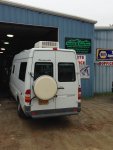
Sway Bar
I'm impressed with how well the Sprinter rides on two tracks and highways, but not as happy with the problem of yaw when going over ruts, bumps, gutters and around sharp curves. From my reading on the matter, it seems that the best fix would be to install a heavier sway bar than the OEM.

I read an article in the local paper about a new shop MaxxDrive that had opened here in Shelby, NC whose owners had a lot of experience in building 4x4s, specializing in lifts and wheels, as well as diesel performance. I drove by and spoke with Jason Edmonson who was familiar with Sprinters. He looked at the sway bar on the van and chuckled, then gave his approval to the one out of the Oregon based Sprinter Store. And he said he would install it for a flat $100.
I talked with the guys in Oregon and ordered their sway bar for the Sprinter 2500. I braced myself for the freight charge, again that Southeast Alaska mind set, and was happy to hear that it would be about $20, for a total of $412.
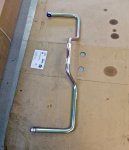
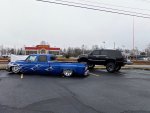
The sway bar was delivered in a week and I was in the shop the next morning. The first thing you notice at Maxx Drive are the three built vehicles parked out front. A lifted Cadillac, a lowered Chevy and a tricked out Hummer. Once inside there is the smell of good rubber from the huge tires, and a visual playground filled with shiny wheels, lights, bull bars and other big boy toys.
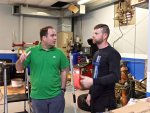
The three bay garage is spotless, there is even cardboard on the floor where an engine might drip during work. Jason and co-owner Rod got a tour of the Cabin and then backed the van into the first bay for the job. Jason was under the van removing the original sway bar while I was still gawking at tires. I gave him a few minutes then asked if I could photograph the old sway bar against the new, but he already had it partially mounted, so the comparison can't be made directly, but suffice it to say that the new one makes the original look like something off a Fiat.
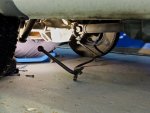
Old Bar
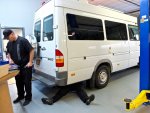
The van drives better with the new sway bar, and not just when coming out of supermarket parking lots. It is also better/tighter on corners.
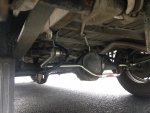
New Bar
For Sprinter drivers, or anyone else with unusual vehicles, I can recommend both Bivens and Maxx Drive for service and hospitality.


